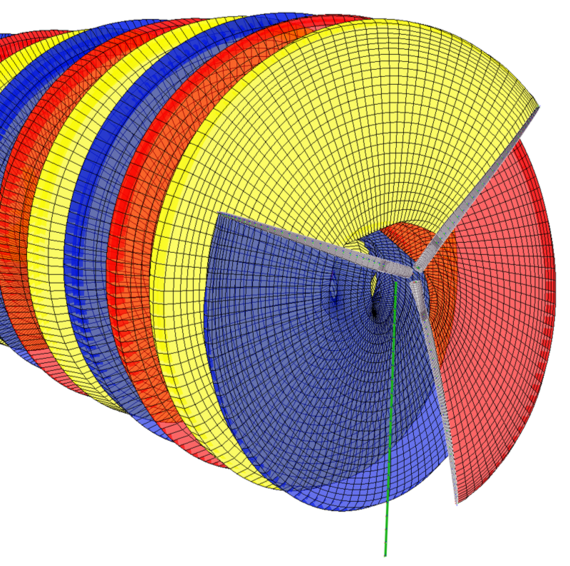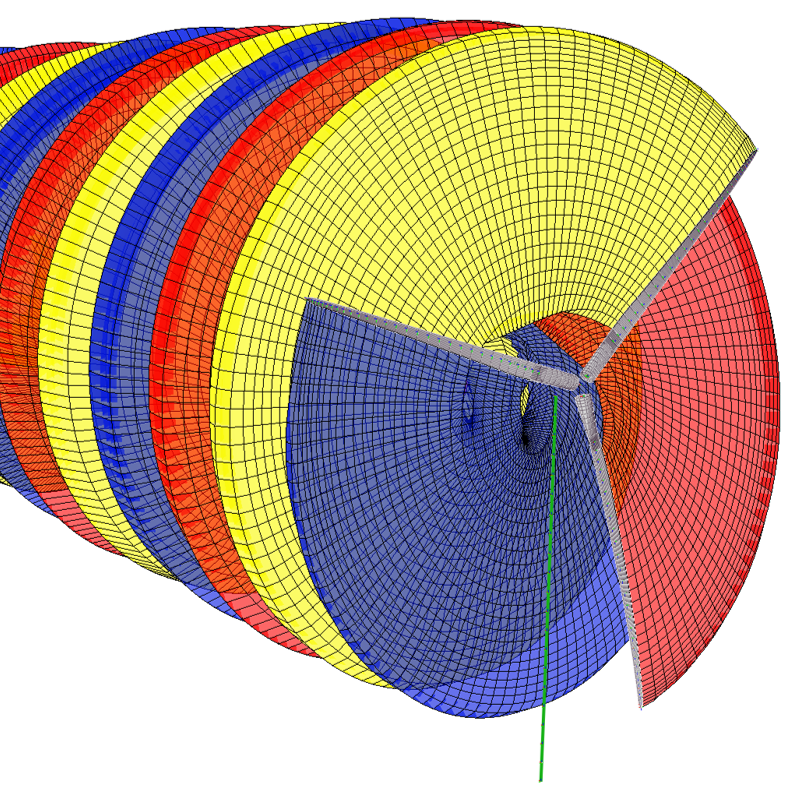The central project Z1 develops the Digital Twin (DT) of an offshore megastructure, defined as a real-time capable, adaptive representation of an offshore megastructure, considering all relevant fluid-structure interactions (FSI), which is the core of CRC 1463. Developing the DT means that Z1 is firstly developing an aero-hydro-servo-elastic simulation framework and secondly integrating the reduced partial models, developed by other subprojects, to include megastructure-specific complex phenomena outside the scope of the basic simulation framework. This close collaboration with all subprojects (SP) via interface developing for the partial models as well as the multi-physical nature of the simulation framework determine the central position of Z1 in the CRC.
The DT is an essential component of the integrated design and operation methodology for offshore megastructures. This results from the research hypothesis that offshore megastructures are subject to nonlinear dynamic interactions, which cannot be neglected and thus new mid-fidelity methods must be used instead of upscaling existing designs. The overarching goals of developing an integrated design and operational methodology using the DT were the motivation in the first funding period and remain in the second funding period.
In the first funding period, an existing in-house software was used as foundation to develop a coupled aero-servo-elastic simulation framework. In particular, great progress was made in the area of strongly coupled FSI. Intensive work was also done on the calculation of aerodynamic loads using the Unsteady Vortex Lattice Method (UVLM). Here, the reliable applicability to wind turbines could be ensured. The structural model was extended by a multi-purpose node-to-node coupling element.
Furthermore, a CRC-wide data exchange format for wind turbine simulations was determined and implemented in intensive cooperation with the concerned SPs. Phenomena, which are relevant for offshore megastructures but too complex to be considered in the overall model of the DT, which aims for real-time capability, are investigated in detail by several dedicated subprojects. Based on their investigations, these SPs develop reduced models, which are integrated into the DT to include megastructure-specific phenomena without compromising the computational efficiency in the form of partial models. They are included in the DT through the collaborative development of interfaces by Z1 and the respective subproject. Representative examples are the standardised controller interface and the use of spatially and temporally resolved wind fields, also via a standard data format.



During the second funding period, the simulation framework will be continuously expanded and optimized. The developments aim to increase computational efficiency of the DT. To achieve this goal, the program code is extensively optimized, and new methods are implemented to enhance the calculation speed of aerodynamic loads, such as the FAST Multipole Method for accelerated wake computation. Furthermore, the time-integration method is being developed further to increase robustness as well as reduce computational effort.
The second main development of the DT in funding period two will be the extension towards offshore including floating wind turbines: by combining the well-known Morison equation with a panel source method in time domain, the hydrodynamic loads on both large and small bodies can be computed. To accurately describe the overall dynamics of floating turbines, a new rod model is being developed, consistent to the current structural module.
Additionally, important physical interactions are integrated through new partial models, e.g., soil damping or dynamic stall. Another key focus is placed on its comprehensive verification and validation. Verification and validation processes not only serve to identify need for improvement of the models but also to evaluate them in terms of their influence on the behaviour of the structure. Ultimately, an overall assessment of the selected mid-fidelity methods should be possible, along with an evaluation of the importance of interactions between partial models. This will allow to check the validity of our research hypothesis
Publications
-
2025: Dynamic displacement measurement of a wind turbine tower using accelerometers: tilt error compensation and validation
Jonscher, C., Helming, P., Märtins, D., Fischer, A., Bonilla, D., Hofmeister, B., Grießmann, T., Rolfes, R. (2025): Dynamic displacement measurement of a wind turbine tower using accelerometers: tilt error compensation and validation, Wind Energ. Sci., 10, 193–205, 2025
-
2024: On an objective, geometrically exact coupling element for a director-based multi-body finite element framework
Märtins, D., Schuster, D., Hente, C., Gebhardt, C. G., Rolfes, R. (2024): On an objective, geometrically exact coupling element for a director-based multi-body finite element framework, Multibody System Dynamics, 2024
-
2024: Analytical linearization od aerodynamic loads in the unsteady vortex-lattice method with applications in nonlinear aeroelasticity
Hente, C., Roccia, B. A., Rolfes, R., Gebhardt, C. G. (2024): Analytical linearization of aerodynamic loads in the unsteady vortex-lattice method with applications in nonlinear aeroelasticity, AIAAJ, 2024
https://doi.org/10.2514/1.J063693
-
2024: Identification uncertainties of bending modes of an onshore wind turbine for vibration-based monitoring
Jonscher, C., Möller, S., Liesecke, L., Schuster, D., Hofmeister, B, Grießmann, T., Rolfes, R.: Identification uncertainties of bending modes of an onshore wind turbine for vibration-based monitoring, Structural Control and Health Monitoring, 3280697, 2024b
-
2024: Accelerating aero-elastic UVLM simulations by inexact Newton algorithms
Schubert, J.; Steinbach, M.C.; Hente, C.; Märtins, D.; Schuster, D. (2024): Accelerating aero-elastic UVLM simulations by inexact Newton algorithms, Computational Mechanics
-
2024: Digital twins in wind energy: advancements in the life-time comprehensive digitization
Bartels, J.-H., Xu, R., Märtins, D., Schuster, D., Rolfes, R., Marx, S. (2024): Digital twins in wind energy: advancements in the life-time comprehensive digitization, 12 Sept. 2024, 15th European Conference on Product & Process Modelling (ECPPM 2024), Dresden, S. 1-8, 8 S.
-
2021: Integrated design and operation methodology for offshore megastructures
Schuster, D., Hente, C., Hübler, C., & Rolfes, R. (2021)
Integrierte Entwurfs‐und Betriebsmethodik für Offshore‐Megastrukturen
Bautechnik, 98(8), 563–570
Subproject management
30167 Hannover
Staff
30167 Hannover
30167 Hannover
